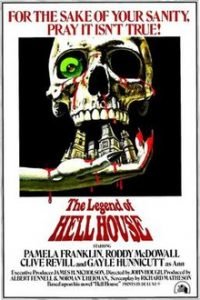 (1973, Rated PG) Pamela Franklin (Florence Tanner), Roddy McDowall (Ben Fisher), Clive Revill (Lionel Barrett), Gayle Hunnicutt (Ann Barrett), Roland Culver (Mr. Deutsch), Peter Bowles (Hanley [Deutsch’s assistant]). Music: Brian Hodgson & Delia Derbyshire. Screenplay: Richard Matheson (based on his novel Hell House). Director: John Hough. 94 minutes.
(1973, Rated PG) Pamela Franklin (Florence Tanner), Roddy McDowall (Ben Fisher), Clive Revill (Lionel Barrett), Gayle Hunnicutt (Ann Barrett), Roland Culver (Mr. Deutsch), Peter Bowles (Hanley [Deutsch’s assistant]). Music: Brian Hodgson & Delia Derbyshire. Screenplay: Richard Matheson (based on his novel Hell House). Director: John Hough. 94 minutes.
Tags: Horror, Haunted House
Notable: Hodgson created many sound effects for Doctor Who; Derbyshire created the electronic version of Ron Grainer’s theme for Doctor Who; two of the six actors of the film are no longer seen after the opening credits roll; Michael Gough (uncredited) appears as Emeric Belasco.
Rating: ★★★★☆
A rich, dying old man hires three psychic investigators to discover the facts regarding survival after death. Their destination: The only indisputably haunted house in the land — the Belasco house, known to the rest of the world as Hell House. Physicist Lionel Barrett is out to prove his theory that “ghosts” are nothing more than electromagnetic phenomena. Mental medium Florence Tanner wants to save the tortured spirits that she feels are haunting the house. Only physical medium Ben Fisher — the only survivor from the last attempt to investigate Hell House, twenty years ago — remains cautious and aloof; he knows too well that something in that house can kill… and he feels sure it’s in the mood to begin killing again.
The classic haunted house film, against which all others must be judged, is Robert Wise’s The Haunting (1963), based on Shirley Jackson’s The Haunting of Hill House. In that film, we never actually see anything — no blood, no guts, no gore, nothing but sounds, lighting, and camera angles. The terror of this film is the creeping horror that takes over the minds of the investigators and the audience. There is, after all, nothing more terrifying than that which you can imagine.
Compared to that bit of classic cinema, most other haunted house stories fall either toward cliché or to mere jump-scares and grotesquery to create their particular brand of terror. This film, however, learned well from the original masterpiece and leaves enough to your imagination (and the imaginations of the investigators on screen) to frighten sufficiently that it would be wise to keep a spare pair of underwear handy when viewing.
The first thing you’ll see in this film is an affidavit by psychic consultant Tom Corbett (yes, a real person from Limerick, Ireland, who was asked by royalty and affluent folk throughout Europe to investigate their ghostly issues) to the effect that everything that happens in the film could actually occur in what we laughingly refer to as “real life.” According to those who have experienced paranormal phenomena (myself included), everything from the slamming doors to breaths of air, from rushing winds to objects moving on their own, even the strange reactions and behaviors of people in the presence of such phenomena… all of this is part and parcel of the experience. There are moments in the film that make one wonder if it is at least partly a recreated documentary rather than mere fiction.
Director John Hough has a nicely creepy touch, utilizing unusual camera angles and offbeat follow-shots that add to the suspense by their ability intensify our sense of being kept off balance. His use of lighting and shadow has the same effect, and this he may have taken from either the book or film of The Haunting. We are told that Hill House was built without a square corner in it, so that everything is slightly off-kilter. Hough and his set designer teamed up to create a means of placing statuary, room dividers, and other impediments to direct lines of travel, giving the viewer the impression that nothing is on the square.
All four of the main actors deliver solid performances throughout, although there are hints about their characters’ past experiences (all of which are relevant to their behavior) that aren’t developed as fully as I’d like. Barrett (Revill) is a scientific cynic, but his almost violent distrust of psychics borders on the pathological; what caused that? His wife Ann (Hunnicutt) hints at marital issues, perhaps a previous infidelity, but it too is not developed fully. When we first meet Florence (Franklin), we see her outside of a church; is she a nun, or considering taking the veil, and is that the reason for her extreme distaste for any aspect of the house’s history of debauchery and depravity? Ben (McDowall) is the most cautious, perhaps to the point of cowardice, and with reason — he saw eight people die because of the house’s evil machinations — but even he seems to have some hidden motivations that we don’t see developed. (I will say, however, that the final confrontation with haunting forces within the house reveals the secrets that Ben couldn’t have foreseen when he investigated the house twenty years prior. With age comes insight, or so I hope.)
Despite those minor flaws, the film is worth watching, several times. Let yourself become immersed in the atmosphere of Hell House, and you will be enthralled right through to the end.
The rather melodramatic but creepy trailer for the film can be found here on YouTube.

I’m now tempted to watch this movie. It sounds like it heavily influenced Tea For Twenty.